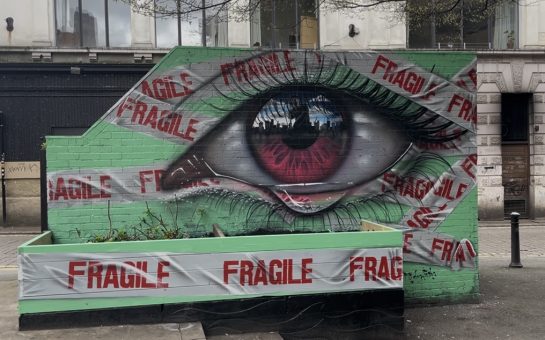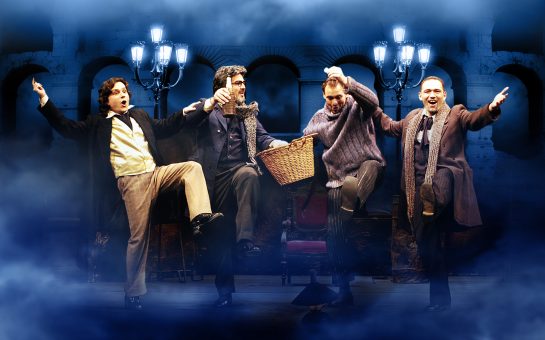She may be a self-confessed ‘woman of few words’, but Alison Erika Forde has managed to express a powerful message in her new exhibition at Manchester Art Gallery.
Part of their on-going programme of Manchester-born artistry, The Tallest of Tales is a complex space to navigate.
There is wisdom to the collection that connotes age better than any accretion of dust ever could, despite the fact that each piece of art is newly completed.
This, combined with the child-like sincerity of the collection, is perhaps as disturbing as the pictures themselves.
Superficially, her paintings are fantastical landscapes full of grotesque figures reminiscent of childhood fantasy, there are, however, hidden depths of dramatic density.
She told MM: “I like to leave the viewer to think for themselves and develop their own stories of what the work could be about.”
A perfect example of this is ‘Let’s All Do the Conga’ – an emulsion and acrylic painting separately framed in four blocks. This disquieting collection, made up of a conga line of animals that have seemingly swapped heads, captures a magnificently fiendish psychoticism, while simultaneously embodying the ingenuous candour of a child’s birthday party.
Innocently enchanting, but ominously sinister, such oxymoronic art is incredibly fresh and original. And yet, because of its tangible primeval wisdom, it fits well with the might of Victorian painters, the abundant intensity of the Pre-Raphaelites, and the nostalgic sublimity of the Romantics also on display. Manchester Art Gallery certainly has the complete package.
“The familiarity of elements within my paintings was intended to entice, and appeal to as broad a range of people as possible,” she said.
And yet Forde’s exhibition is so much more than a handful of paintings. It is never a bad thing to demand innovation from every aspect of your work, and if the paintings themselves weren’t thought-provoking enough, her free-standing pieces assuredly baffle the logical mind.
In the centre of the room stands a hut. It is painted to look typically wooden, and inside, behind the curtain of multi-coloured ribbon, is a lamp (affectionately called Sandra) with a doll sat at its base and a series of paintings, ‘The Bitches’, present on its walls.

The idea of a room within a room is most definitely original, but the wacky interior of the cabin crosses that figurative boundary between the inventive and the pioneering.
She said: “Working on the more unusual objects is a lot more challenging; every piece is completely different which appeases my relatively short attention span. I hate to feel stagnant.
“The hut is quite different from the other objects, it’s a recurrent theme within my work, but it was purpose built rather than something that I found. It’s an element of my paintings that has been brought to life.”
Like the hut, ‘The Tower’ is a law unto itself. Constructed of four cylindrical drums, the sequence from underground to above-sky is a powerful evocation of the inalienable place of nature in art. Bird-like figures swoop from the clouds, decapitated skulls abound beneath the soil, and a young woman clings to the moon’s nose; all told, things are not as they seem.
‘All told’ is a phrase that works with Forde’s Tallest of Tales exhibition. Representations of childhood nightmares, as in her ‘Shadow Creeps’, ‘The Black Unicorn’, and ‘Silent Slumber’, and folkloric legend, from ‘The Granddad Tree’ to ‘Iris’, strike an evocative chord with all of us, being rooted in fear and joy – the most primal and universal form of ancestry. Though strange and more than a little unnerving, Forde’s work speaks volumes because of this very unanimity.
The stand-out piece of the collection, however, has to be ‘The Lady in the Lake’. A grandiose be-frosted forest accommodates a modern-day, atypically subversive Lady Godiva. Luxuriantly bathing her hairy legs in the foreground lagoon, the surrounding trees contain the faces of several peeping Toms (and Tabithas) whose expressions are enticingly secreted between the branches.
Wholly engaging in its playful insouciance and the overwhelming presence of its organic setting, this piece has an engrossing potency that makes for lengthy viewing.
Universally appealing, her art is hardly a well-kept secret. With exhibitions in The Olbricht Collection, Collection Robert Devereux and private collections in Austria, Germany, Spain, Switzerland, the Netherlands, USA and the UK the secrecy conveyed in the work of this MMU graduate is certainly not mirrored in real life.
Yet this seems to prove a point – that art is universally accepted when it is comprehensively alluring, and that across cultures, great art still has an inimitable power to speak for itself.
“A lot of the time I’ll set the scene for a painting somewhere I’d quite like to inhabit. They’re partly my daydreams in paint,” she said.
From the vision-like outlandishness of her work, and its intoxicating ability to throw your mind to a place thought to be long forgotten, one can see exactly what she means.
On display at Manchester Art Gallery until November 10, Alison Erika Forde’s Tallest of Tales exhibition is a compelling collection of modern art that ought to feature high on everyone’s list of priorities.
Your inner child will thank you for it.
For more on this story and many others, follow Mancunian Matters on Twitter and Facebook.



